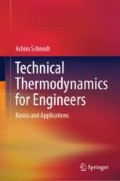Abstract
Steady state flow processes have already been discussed when introducing the first law of thermodynamics for open systems, see Sect. 11.3. Figure 21.1 shows an example for a simple open system with a single inlet and a single outlet. Characteristic for open systems in steady state is, that the mass inside the system remains constant with respect to time, so that the mass flux into the system needs to be balanced by the mass flux out of the system, i.e.
Access this chapter
Tax calculation will be finalised at checkout
Purchases are for personal use only
Notes
- 1.
The total pressure is composed of the static pressure p, that a person would be faced who is following the flow with its velocity c, the dynamic pressure \(\frac{\rho }{2}c^{2}\) and the hydraulic pressure \(g\rho z \).
- 2.
Generally speaking, potential energies can be neglected as long as the vertical distance between inlet and outlet is not huge in size.
- 3.
No matter what fluid is used!
- 4.
Mind the units! The specific enthalpy should be converted in \(\frac{\text {J}}{\text {kg}}\).
- 5.
A nozzle is a work-insulated, i.e. passive, system.
- 6.
Imagine a pressure pulse is traveling with a velocity \(a=100\,\frac{\text {km}}{\text {h}}\) from right to left, facing a headwind of \(c=20\,\frac{\text {km}}{\text {h}}\). Thus, the fluid hits the pulse front with a velocity of \(120\,\frac{\text {km}}{\text {h}}\). However, the fluid’s velocity behind the pulse shall be slightly higher, e.g. \(c+\text {d}c=22\,\frac{\text {km}}{\text {h}}\), so that the velocity rises by \(\text {d}c=2\,\frac{\text {km}}{\text {h}}\). If we want the air to face the pulse front with exactly the velocity \(a=100\,\frac{\text {km}}{\text {h}}\), the coordinate system needs to go with a velocity of \(a-c=80\,\frac{\text {km}}{\text {h}}\) to the left. In this case the velocity of the air leaving the coordinate system on the right hand side is \(a+dc=102\,\frac{\text {km}}{\text {h}}\). Mind, that for balancing any coordinate system can be applied. The solution must never depend on the choice of the coordinate system!
- 7.
Ignoring potential energies!
- 8.
For instance by its internal state \(p_{1}\), \(T_{1}\) and its velocity \(c_{1}\).
- 9.
\(T_{\text {ref}}\), \(p_{\text {ref}}\), \(h_{\text {ref}}\) and \(s_{\text {ref}}\) represent a arbitrary reference state!
- 10.
Compare with Problem 12.10!
- 11.
Sure, it can remain constant, but then there would be no driver for any changes of the flow.
- 12.
\(T_{\text {ref}}\), \(p_{\text {ref}}\), \(h_{\text {ref}}\) and \(s_{\text {ref}}\) represent a arbitrary reference state!
- 13.
Thus, at large subsonic velocities!
- 14.
For a given \(p_{0}\) it is not possible to reach a pressure smaller than \(p_{\text {crit}}\) in a converging nozzle, see sketch 21.25.
- 15.
This is equivalent with a constant total pressure. Mind, that no dissipation occurs.
Author information
Authors and Affiliations
Corresponding author
Rights and permissions
Copyright information
© 2019 Springer Nature Switzerland AG
About this chapter
Cite this chapter
Schmidt, A. (2019). Steady State Flow Processes. In: Technical Thermodynamics for Engineers. Springer, Cham. https://doi.org/10.1007/978-3-030-20397-9_21
Download citation
DOI: https://doi.org/10.1007/978-3-030-20397-9_21
Published:
Publisher Name: Springer, Cham
Print ISBN: 978-3-030-20396-2
Online ISBN: 978-3-030-20397-9
eBook Packages: EngineeringEngineering (R0)

